Is Beef Safe to Eat Now
1 / 10
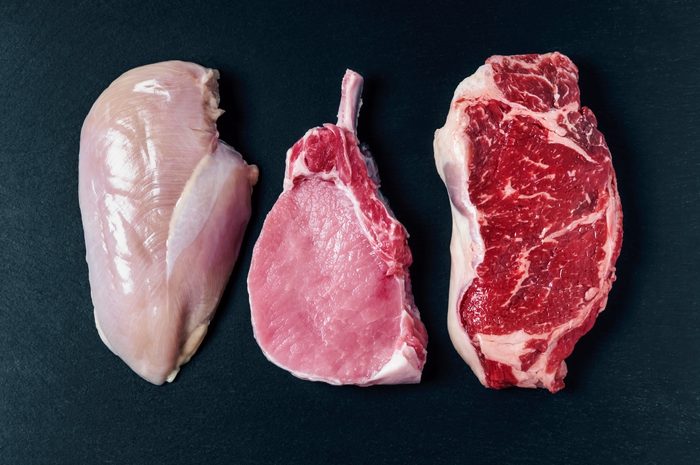
Protein panic
Ever since the news about the coronavirus infections at the Smithfield pork processing plant in South Dakota broke, people have been concerned about the safety of the meat they eat. The good news, says Donald Schaffner, PhD, a professor of food microbiology at the School of Environmental and Biological Sciences at Rutgers University, is that there is no evidence that you can contract COVID-19 from eating tainted food.
Meat is as safe as it ever was—but that doesn't exactly mean it's risk-free. Salmonella, E. coli, and norovirus are just some of the foodborne illness–causing microorganisms found in all kinds of raw meat, from chicken to seafood. Raw or undercooked meat, poultry, and shellfish are among the most likely sources of food poisoning, according to the U.S. Centers for Disease Control and Prevention. If you're nervous about grocery stores during COVID-19, find out some places to buy meat that aren't supermarkets.
2 / 10
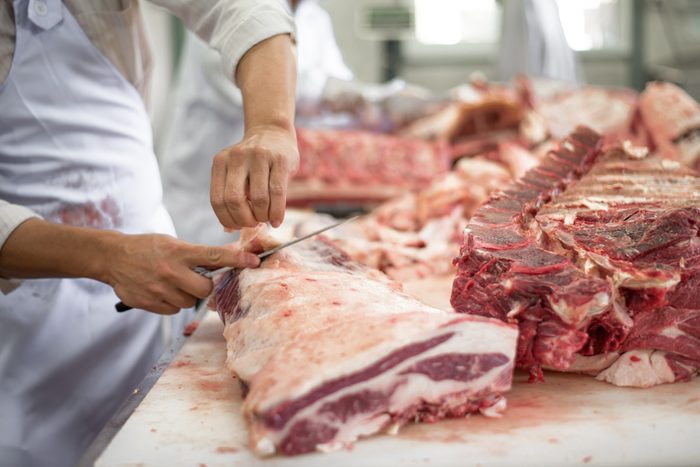
The food (contamination) chain
Meat can become tainted at any point in the supply chain. Some pathogens, such as E. coli and Salmonella, are naturally found in the digestive tracts of many of the animals we consume. "Contamination can happen anywhere along the process from processing and packaging to cooking," says Gary Acuff, a retired professor of food microbiology at Texas A&M University who now runs his own consulting business. "Typically, if animals are healthy, they don't have bacteria in their muscle tissue, but contaminated surfaces can spread bacteria around." That can happen at the butcher's, in the store, or in your own home.
3 / 10
An invisible threat
Of course, if you could spot tainted meat, it would be easy to avoid it. Unfortunately, Schaffner says, "Microorganisms are microscopic, so you can't see them." In fact, none of your regular senses—smell, taste, or touch—are able to indicate whether a piece of meat is harboring illness-causing bacteria. And studies that have examined organic versus conventionally raised livestock "tend not to show a difference," says Schaffner. Ditto for other marketing buzzwords like "free-range" and "grass-fed." This is what grass-fed beef really means.
4 / 10

Hot dogs, bacon, and chicken nuggets
Still, some kinds and cuts of meat do tend to pose a greater risk than others—and the ones that are considered the safest may surprise you. Strictly from a food safety standpoint, experts agree that the lowest risk comes from processed meats, particularly those that are likely to be cooked again, such as hot dogs, bacon, and chicken nuggets. (Yes, the same kinds of foods most other health professionals tell you to avoid.) Processing tends to eliminate any disease-causing pathogens, and cooking these foods according to package directions is an extra precaution. Of course, sometimes processing adds unsavory ingredients.
5 / 10

Deli meats
Surprisingly, food safety experts consider deli meats the second safest option. Again, these meats have been processed, so even without being cooked a second time like hot dogs and sausages, they are unlikely to cause any digestive issues. Deli meats tend to get a bad rap because pregnant women, older adults, and individuals with compromised immune systems are warned to avoid them, since in rare cases they harbor bacteria known as Listeria, which is known to cause miscarriages, stillbirths, and other complications in fetuses and newborns. Of course, there are other reasons you may want to limit your intake of deli meats, such as nitrates. Make sure you're not making this dangerous mistake with your meat thermometer.
6 / 10
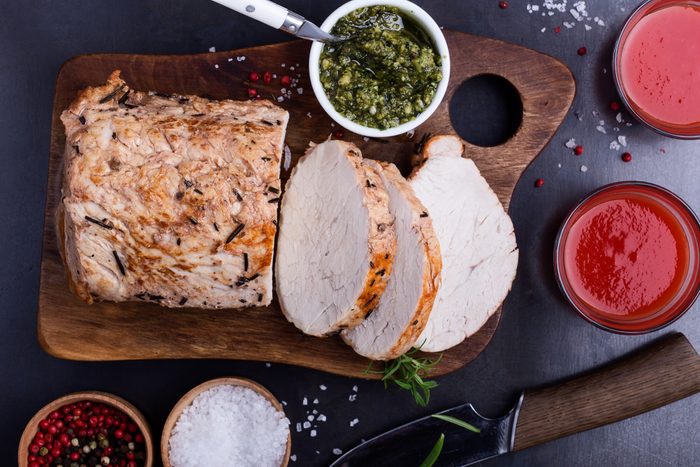
Pork
For a long time, pork was considered one of the riskiest meats due to the prevalence of a parasite called Trichinella; consuming raw or undercooked pork that was infected with the parasite causes a disease known as trichinosis or trichinellosis. But that disease has all but been eradicated, say experts, thanks in large part to a public awareness campaign about the dangers of undercooked pork. An average of only 16 cases per year were reported between 2011 to 2015, according to the CDC, and pork is now considered one of the safest meats to consume—so safe that in 2011, the USDA guidelines lowered the safe cooking temperature of whole pork cuts to 145 degrees F (ground pork remains 160 degrees F, however). Find out why the cost of meat might be going up in restaurants.
7 / 10

Cooked seafood
In addition to seafood's many other benefits, it's rarely the source of foodborne illnesses. "You don't hear about a lot of people getting sick from sushi," says Acuff. That could be because a lot of seafood, including sushi-grade fish, is flash-frozen when it's caught, which kills off any bacteria or parasites. Experts say that "chicken of the sea" could be even lower risk than actual chicken in this regard. There are exceptions, of course. Raw oysters can contain an infectious bacteria known as Vibrio, and those harvested from contaminated waters may carry norovirus. But in general, cooked seafood is a low-risk source of protein.
8 / 10
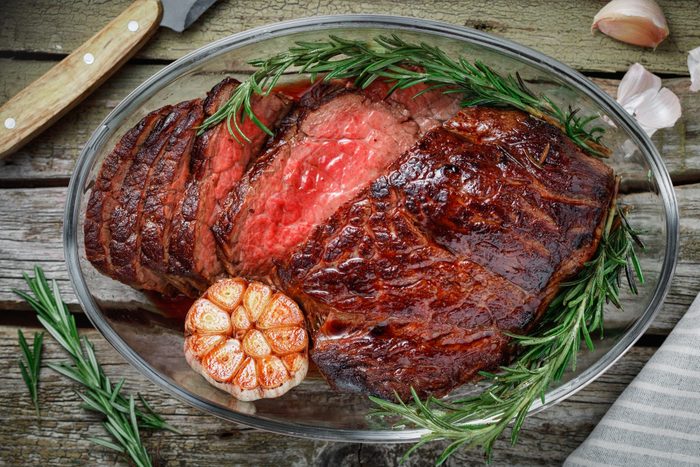
Marinated steaks
One of the main concerns about red meat and illness-causing pathogens involves how some packaged steaks are processed. Some companies tenderize their steaks using a mechanical procedure in which metal blades or pins puncture the surface of the meat before it is packaged. Acuff says it is unlikely that the needles will push bacteria into the meat, given that the equipment is sterilized, but any kind of marinade could introduce pathogens into those openings. That's why he tends to be wary of pre-marinated meats and prefers to do it himself at home. Be sure to avoid these 13 grilling mistakes that could make you sick.
9 / 10

Chicken
Chicken tends to be responsible for the most foodborne illnesses, but that is likely because it's the kind of meat we eat the most. Many cases of food contamination come from the mishandling of meats and cross-contamination in our own kitchens. Poultry tends to be especially susceptible to this because it's often packaged with more liquid that can splash on surfaces. Acuff says this is due to a practice known as "crust freezing," in which only the surface of the poultry is frozen for transport. When it thaws again, liquid pools around the meat in the container. You should always pat your meat dry with paper towels and use a dedicated cutting board for raw meat to avoid transferring bacteria from one area of the kitchen to another. In fact, you should never wash chicken before cooking it.
10 / 10
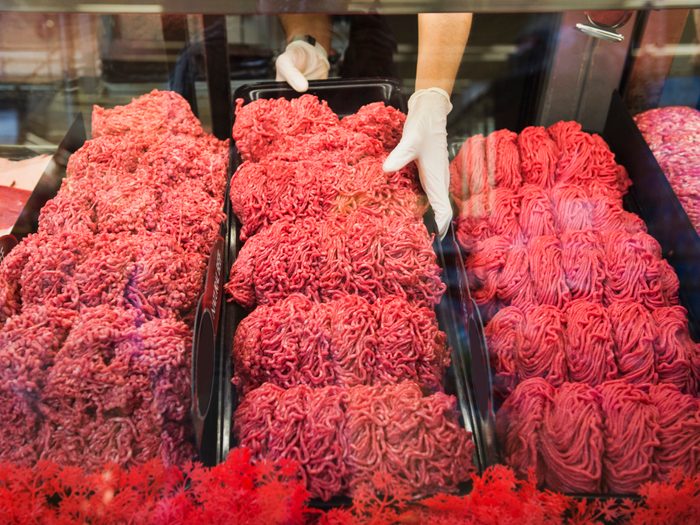
Use caution with ground meat
When it comes to food poisoning, the riskiest kind of meat, hands down, is ground meat, experts agree. Whether it's chicken or turkey, pork, or beef, grinding the meat increases the amount of surface area that can come into contact with disease-causing pathogens. For that reason, it's vital to cook anything made from ground meat—hamburgers, meatballs, meatloaf—fully through. That means ordering your burgers well-done—advice many grill aficionados may find, um, hard to swallow. Find out the answers to your 11 biggest questions about grilling.
Originally Published: June 18, 2020
Source: https://www.rd.com/list/safest-types-of-meat/
0 Response to "Is Beef Safe to Eat Now"
Post a Comment